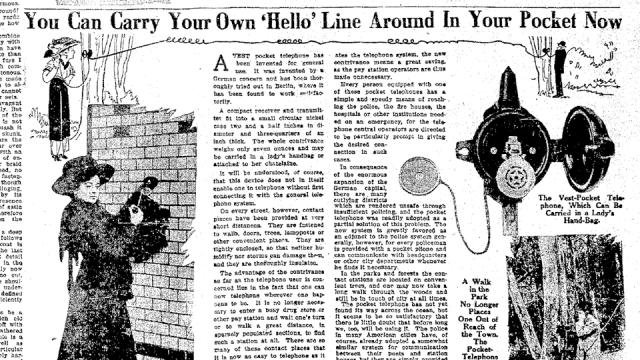You’ve almost certainly got a telephone in your pocket (or clutch), but don’t think for a second that it makes you any kind of pioneer. People were predicting — and using — pocket telephones more than a century go, for reasons every bit as lethargic as your own.
A story in the Reno Evening Gazette on April 30, 1910, explained a new gadget that was being used by police to call back to their precincts. It was a primitive, battery-powered wiretap that could be plugged into existing telephone lines that anybody may have access to on the street.
The newspaper predicted that soon, everyone would be carrying these pocket telephones with them. And that it would mean instantaneous communication might soon be possible from just about anywhere — provided there was a telephone line within arm’s reach. The telephone booth, they promised, would soon be a thing of the past. And talking to other people within your own house would be as easy as pushing a button.
In a few years, it is not unreasonable to expect, people may be seen adjusting their pocket transmitters to telephone plugs along the streets, in the parks, in public buildings, at the counters in department stores, wherever they may chance to be, just as they now enter telephone booths.
Of course, with the general application of the pocket transmitter-plug system one will be able to telephone from any part of one’s house or flat, also. There will be no more running away from the table when the bell rings. The man who is doing the carving may simply affix this transmitter to a plug on the festive board and begin talking. Similarly, one may telephone from the bed to the kitchen. Everybody who may possess a transmitter will probably be able to telephone with little or no trouble. And doubtless talk will be cheaper.
The dream of the pocket telephone as an everyday device continued through the early 1910s. A couple of years after the article in the Reno Gazette, the January 7, 1912 Lima Daily News in Ohio described a pocket telephone that was being developed in Germany. Weighing just seven ounces, the device would fit inside any woman’s purse. The pocket telephone would be great for emergencies, the Daily News explained, and there’d be no more waiting in line at stores open to the public to make a call. One might miss the privacy of the telephone booth, but the Lima Daily News assured readers that there was an easy fix for that: just talk quietly.
Why didn’t this pocket telephone take off? For a number of very good technological reasons, but the most pressing had to do with money. Reference to “talk will be cheaper” was referring to the fact that people would be able to talk for much longer, but dollars and cents were a larger concern for the phone companies. How do you charge someone who’s haphazardly tapping (literally wiretapping) into your service?
Communication today has indeed become cheap and easy for the majority of the world. More people in the year 2013 have access to cellphones than toilets, and we no longer need to find a random telephone wire to use our “pocket telephones.” And thank goodness; can you imagine how hard it would be to send a Snapchat with a rotary phone?
Picture: January 7, 1912 Lima Daily News
